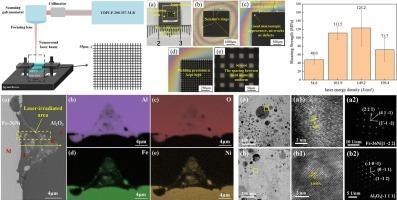蓝宝石与英瓦尔合金的纳秒激光直接连接
IF 7.9
2区 材料科学
Q1 MATERIALS SCIENCE, MULTIDISCIPLINARY
引用次数: 0
摘要
本研究首次利用纳秒激光实现了单晶蓝宝石与因瓦尔合金的直接连接。分析了蓝宝石/因瓦尔合金接头的宏观组织和微观组织,并对其成分特征进行了研究。在此基础上,探讨了纳秒激光加工参数对接头宏观、微观组织及力学性能的影响。研究了蓝宝石/因瓦尔合金接头的典型断裂形态,揭示了其断裂机制。激光辐照区呈圆锥形熔融区,主要由蓝宝石和少量因瓦尔合金颗粒组成。结合区域未发现新相,主要结合机制为机械联锁和嵌套。优化纳秒激光焊接参数后,接头抗剪强度达到123.2 MPa。此外,纳秒激光焊接的密封蓝宝石/Invar合金样品通过了336小时的防水测试,没有任何泄漏。激光辐照区锥形焊缝结构产生的机械联锁效应对提高抗剪强度起关键作用。本文章由计算机程序翻译,如有差异,请以英文原文为准。

Direct joining of sapphire and Invar alloy by nanosecond laser
The direct joining of single-crystal sapphire and Invar alloy using a nanosecond laser is demonstrated for the first time in this study. The macro- and microstructures of the sapphire/Invar alloy joints were analyzed, along with an investigation of their compositional characteristics. Based on this, the effects of nanosecond laser processing parameters on the joint’s macro- and microstructures and its mechanical performance were explored. The typical fracture morphologies of the sapphire/Invar alloy joints were examined, revealing the fracture mechanisms involved. The laser-irradiated area exhibited a conical molten zone, predominantly composed of sapphire with a small amount of Invar alloy particles. No new phases were detected in the joint region, and the primary joining mechanism was identified as mechanical interlocking and embedding. After optimizing the nanosecond laser welding parameters, the joint’s shear strength reached 123.2 MPa. Additionally, the sealed sapphire/Invar alloy samples welded by nanosecond laser passed a 336-hour water resistance test without any leakage. The mechanical interlocking effect generated by the conical weld seam structure in the laser-irradiated area played a key role in enhancing shear strength.
求助全文
通过发布文献求助,成功后即可免费获取论文全文。
去求助
来源期刊

Materials & Design
Engineering-Mechanical Engineering
CiteScore
14.30
自引率
7.10%
发文量
1028
审稿时长
85 days
期刊介绍:
Materials and Design is a multi-disciplinary journal that publishes original research reports, review articles, and express communications. The journal focuses on studying the structure and properties of inorganic and organic materials, advancements in synthesis, processing, characterization, and testing, the design of materials and engineering systems, and their applications in technology. It aims to bring together various aspects of materials science, engineering, physics, and chemistry.
The journal explores themes ranging from materials to design and aims to reveal the connections between natural and artificial materials, as well as experiment and modeling. Manuscripts submitted to Materials and Design should contain elements of discovery and surprise, as they often contribute new insights into the architecture and function of matter.
 求助内容:
求助内容: 应助结果提醒方式:
应助结果提醒方式:


